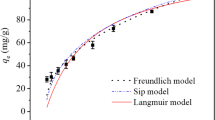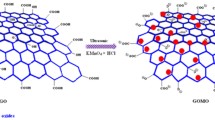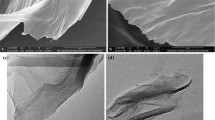Abstract
Adsorptive behavior of uranium from aqueous solution on graphene oxide supported on sepiolite composites (GO@sepiolite composites) as a function of pH, ionic strength, temperature and initial uranium concentration was carried out by the batch techniques. GO@sepiolite composites was synthesized and characterized by X-ray diffraction (XRD), scanning electron microscopy (SEM), and potentiometric acid–base titration. According to XRD patterns and SEM images, the graphene oxide nanosheets were grafted on sepiolite surface successfully. The macroscopic results showed that the adsorption of uranium on GO@sepiolite composites was significantly depended on pH, whereas no effect of ionic strength on uranium adsorption at high pH and high ionic strength conditions was observed. The uptake equilibrium is best described by Langmuir adsorption isotherm, and the maximum adsorption capacity (Qe) of GO@sepiolite composites at pH 5.0 and T = 298 K were calculated to be 161.29 mg/g. Thermodynamic results indicated that the adsorption of uranium on GO@sepiolite composites is the spontaneous and exothermic process.
Similar content being viewed by others
Explore related subjects
Discover the latest articles, news and stories from top researchers in related subjects.Avoid common mistakes on your manuscript.
Introduction
The adsorption of uranium from aqueous solution by adsorbents has been widely investigated in recent years, such as clay minerals [1–5], silica [6–8], and zeolite [9–11]. In these studies, the maximum adsorption capacities of natural materials for uranium are mainly in the level of ~10−6–10−3 mol/g under various environmental conditions. In order to increase its strong affinity and high loading capacity for targeted radionuclides, the surface modification of various adsorbents have been developed last several years [12, 13]. Kilislioglu and Aras [13] modified the surface of sepiolite by using heat and acid treatment. The authors found the maximum adsorption capacity of HCl treated and heat treated sepiolite was 3.58 × 10−3 and 3.14 × 10−3 mol/g, respectively, which is much higher than that of natural sepiolite (2.78 × 10−3 mol/g).
Graphene oxide nanosheets with strong affinity and high loading capacity for radionuclides have been investigated [14, 15]. Sun et al. [15] found that the maximum adsorption capacity of graphene oxide nanosheets for Eu(III) at pH 5.0 and T = 298 K was calculated to be 175 mg/g. The unique properties (i.e., huge specific surface area and large delocalized π–electron systems) make graphene oxide nanosheets favorable for wastewater treatment. However, the aggregation and accumulation of graphene oxide nanosheets in aqueous solution significantly decrease its adsorption performance. Having a composite of graphene oxide nanosheets supported on fibrous sepiolite might be helpful to overcome this limitation.
In this study, graphene oxide nanosheets were linked to clay mineral by performing organomodification on commercially available sepiolite surface. Graphene oxide supported on sepiolite composites (GO@sepiolite composites) were synthesized under coupling agent conditions. The purpose of this study was: (1) to characterize the microscopic and macroscopic properties of GO@sepiolite composites by X-ray diffraction (XRD), potentiometric acid–base titration, and scanning electron microscopy (SEM); (2) to study the effect of pH, ionic strength and temperature on uranium adsorption from aqueous solution by the batch technique and (3) to determine the adsorption mechanism of uranium on GO@sepiolite. The highlight of this paper is the broad applicability of this novel material in environmental pollution cleanup.
Experimental
Materials
The graphene oxide nanosheets were prepared in terms of modified Hummers method [16]. Typically, flake graphite was strongly oxidized by using KMnO4 and concentrated H2SO4 under the vigorous stirring conditions, and excess oxidative agents were eliminated by using H2O2 (30 % of aqueous solution). The GOs were obtained by centrifugation at 18000 rpm for 30 min and rinsed repeatedly by using Milli-Q water.
Sepiolite obtained from Hehan coal mine in middle of China, which is composed of ~90 % sepiolite, 8 % dolomite, 2 % smectite and quartz in trace level. The natural sepiolite was ground and sieved to 200 mesh nylon sieves. GO@sepiolite composites were synthesized by interaction of the carboxyl groups of GO and the amino groups of an amino-terminated sepiolite under coupling agent (N-hydroxysuccinimide). All chemical reagents used in this study were of analytical reagent grade (AR Grade).
Solutions of uranium were prepared by dissolving known quantities of uranyl acetate (UO2(CH3COO)2·2H2O in Milli-Q water.
Characterization of GO@sepiolite composites
The GO@sepiolite composites were characterized by XRD, potentiometric titration, and SEM. The XRD measurements were mounted by Cu Kα radiation generated in the Phillips XRG 300 X-ray diffractometer at step scan increment of 0.2° and a dwell time of 2 s. The potentiometric acid–base titration measurements were performed with a Mettler automatic titrator (DL5X, Switzerland) under N2 conditions to eliminate the influence of atmospheric CO2. Subsamples of the materials investigated of approximately 0.1 g in 40 mL 0.01 mol/L NaClO4 were placed in a container maintained at 25 °C and equilibrated overnight with the electrolyte solution. The SEM measurements were recorded by using a field emission scanning electron microscope (FEI-JSM 6320F, Japan).
The batch adsorption experiments
The adsorption of uranium on pristine GO, natural sepiolite, and GO@sepiolite composites was conducted by a batch technique. A known weight of adsorbents was equilibrated with definite volume of uranium solution in a polycarbonate centrifuge tubes at a fixed temperature in a thermostated shaker water bath for 48 h. Preliminary experiments had shown that uranium adsorption achieved equilibration within 24 h. The pH of suspension was adjusted by adding neglected volume of 0.1 mol/L NaOH or HClO4 solution. The supernatant was filtered by using 0.2 μm filter after centrifugation it at 18,000 rpm for 30 min. The residual uranium ions in aqueous solution were determined using kinetic phosphorescence analyzer (KPA-11, Richland, USA). The amount of adsorbed uranium was calculated from the difference of the uranium concentration in initial solution and equilibrated concentration in aqueous solution by using Eq. (1):
where C 0 and C e are the concentration of uranium ions in initial and final solutions, respectively.
Results and discussion
Characterization of GO@sepiolite composites
The GO@sepiolite composites were characterized by XRD, potentiometric titration, and SEM. As shown in Fig. 1a, the natural sepiolite was pure in terms of XRD patterns, the intensity of peaks at 2θ = 26.2° abruptly increased for GO@sepiolite composites, which is characteristic peak of GO nanosheets [17]. The XRD patterns indicate that GO nanosheets were grafted on sepiolite surface successfully. The immobilization of GO nanosheets on the sepiolite surface was also confirmed and characterized by SEM analysis. According to potentiometric titration (Fig. 1b), the more volume of NaOH was consumed for GO@sepiolite composites, indicating that the protonation–deprotonation reaction of GO@sepiolite composites shift to the high pH. The results of potentiometric titration reveal that a large number of functional groups such as hydroxyl groups, carboxyl groups and epoxy groups were observed [15]. The morphologies of bare amino-sepiolite particle and GO@sepiolite composites were showed in Fig. 1c, d, respectively. It can be seen that the natural amino-sepiolite particle has a fibrous shape and a clear and smooth surface. As shown in Fig. 1d, the surface of amino-sepiolite particles was encapsulated by GO nanosheets. It can also be clearly observed that GO@sepiolite composites are tightly covered by the corrugated GO nanosheets. The characterization results indicate that GO nanosheets were grafted onto the sepiolite surface successfully.
Effect of pH
The pH in aqueous solution is the most important parameter influencing the adsorption behaviors. The effect of pH on uranium adsorption onto pristine GO, natural sepiolite, GO@sepiolite composites was studied over wide range of pH from pH 2.0–11.0. As can be seen in Fig. 2, the adsorption of uranium on pristine GO nanosheets, natural sepiolite and GO@sepiolite composites increases with increasing pH in the pH range 2.0–7.0, then reaches the maximum level at 7.0–8.0, whereas the adsorption is gradually decreased with further increasing pH in the pH range 9.0–12.0. The adsorption of uranium on GO@sepiolite composites was affected by the solution pH through the hydrolysis of uranyl ions in aqueous solution. At pH 2.0–6.0, uranium exists in hydrolyzed form such as UO2 2+, (UO2)2(OH) 2+2 , (UO2)3(OH) +5 species [18]. Moreover, the more reactive sites are available with increasing pH. Therefore, the adsorption of uranium on GO@sepiolite composites increases with increasing pH from 2.0 to 7.0. In the pH range of 8.0–10.0, the soluble carbonate complexes such as UO2(CO3) 2−2 and UO2(CO3) 4−3 species are the dominant anion species [19], which suppress the adsorption of uranium onto GO@sepiolite composites. A similar phenomenon was also observed elsewhere [3, 20–24].
Effect of ionic strength
The adsorption mechanism of uranium on GO@sepiolite composites can be determined by investigating the effect of ionic strength [25–28]. As shown in Fig. 3, the adsorption of uranium on GO@sepiolite composites is sensitive to ionic strength at low pH conditions, whereas the adsorption of uranium on GO@sepiolite composites shows a distinct independency of ionic strength at high pH conditions. It can be deduced that ion exchange is the dominant mechanjism for uranium adsorption on GO@sepiolite composites at low ionic strength and low pH conditions whereas surface complexation is the dominant mechanism at high ionic strength and high pH conditions.
Effect of initial concentration
The adsorption of uranium on pristine GO, natural sepiolite and GO@sepiolite composites as a function of uranium concentration was studied at room temperature by varying uranium concentration from 10 to 50 mg/L, while keeping all other parameters constant. As shown in Fig. 4, the adsorption of uranium on these adsorbents is found to decrease in the order GO@sepiolite > GO > sepiolite. The maximum adsorption capacity (Qmax) of GO@sepiolite, GO and sepiolite at pH 5.0 and T = 298 K were calculated to be 161.3, 119.0, 89.3 mg/g in terms of Langmuir model.
Thermodynamic parameters
Effect of temperature was also conducted for uranium in the range of 25–60 °C. As shown in Fig. 5, the adsorption of uranium on GO@sepiolite composites increases with increasing temperature. Thermodynamic parameters such as free energy change (ΔG 0), enthalpy change (ΔH 0) and entropy change (ΔS 0) can be calculated from the slope and intercepts of linear variation of ln K d with the reciprocal of the temperature (1/T) by using Eqs. (2) and (3), respectively:
where R is the universal gas constant (8.314 J·mol−1·K−1), T is the temperature in Kelvin. K 0 is adsorption equilibrium constants, which can be calculated by plotting ln K d vs C e and extrapolating C e to zero. Table 1.
As given in Table 2, the value of ΔG 0 was calculated to be −10.926 kJ/mol at T = 298 K, −12.626 kJ/mol at T = 318 K, and −14.108 kJ/mol at T = 338 K, respectively. The value of ΔH 0 and ΔS 0 was calculated to be 12.815 kJ·mol−1 and 79.777 J·mol−1·K−1, respectively. The positive value of ΔH 0 for uranium adsorption indicates that uranium adsorption on GO@sepiolite composites is an endothermic process. For uranium to adsorb on GO@sepiolite composites, they have to have their hydration sheath denuded to some extent, and this dehydration process needs energy. The positive ΔS 0 value of uranium also indicates that the adsorption process is spontaneous with high affinity. The negative ΔG 0 values of uranium also indicate the spontaneous process of uranium sorption under the conditions applied. The decrease of ΔG 0 with increasing temperature indicates more efficient adsorption at higher temperatures. The thermodynamic parameters reflect the affinity of GO@sepiolite composites toward uranium ions in aqueous solutions and may suggest some structural changes in the sorbent [29, 30].
Conclusions
The adsorptions of uranium on the GO@sepiolite composites, pristine GO and natural sepiolite was simultaneously studied using the batch-type technique. It is found that the environmental factors such as pH, ionic strength, initial uranium concentration and temperature had a significant influence on the adsorption of uranium. The adsorption of uranium on these adsorbents were found to decrease in the order GO@sepiolite > GO > sepiolite. The equilibrium data are more agreeable with Langmuir isotherm than Freundlich isotherm. The mechanism of uranium adsorption on GO@sepiolite composites was determined to ion exchange at low pH and surface complexation under alkaline conditions.
References
Sylwester E, Hudson E, Allen P (2000) Geochim Cosmochim Acta 64:2431
Hyun S, Cho Y, Hahn P, Kim S (2001) J Radioanal Nucl Chem 250:55
Donat R, Esen K, Cetisli H, Aytas S (2009) J Radioanal Nucl Chem 279:253
Mckinley J, Zachara J, Smith S, Turner G (1995) Clays Clay Miner 43:586
Jung J, Hyun S, Lee J, Cho Y, Hahn P (1999) J Radioanal Nucl Chem 242:405
Venkatesan K, Sukumaran V, Antony M (2004) J Radioanal Nucl Chem 260:443
Al-Attar L, Dyer A, Blackburn R (2000) J Radioanal Nucl Chem 246:451
Zhang X, Tao Z (2002) J Radioanal Nucl Chem 254:103
Aytas S, Akyil S, Eral M (2004) J Radioanal Nucl Chem 260:119
Kilincarslan A, Akyil S (2005) J Radioanal Nucl Chem 264:541
Simsek S, Ulusoy U (2012) J Radioanal Nucl Chem 292:41
Donat R, Cilgi G, Aytas S, Cetisli H (2009) J Radioanal Nucl Chem 279:271
Kilislioglu A, Aras G (2010) Appl Radiat Isot 68:2016
Zhao G, Wen T, Yang X, Yang S, Liao J, Hu J, Shao D, Wang X (2012) Dalton Trans 41:6182
Sun Y, Wang Q, Chen C, Tan X, Wang X (2012) Environ Sci Technol 46:6020
Hummers W, Offeman R (1958) J Am Chem Soc 80:1339
Fan X, Peng W, Li Y, Li X, Wang S, Zhang G, Zhang F (2008) Adv Mater 20:4490
Abbasi W, Streat M (1994) Sep Sci Technol 29:1217
Bargar J, Reitmeyer R, Lenhart J, Davis J (2000) Geochim Cosmochim Acta 64:2737
Guo Z, Yan Z, Tao Z (2004) J Radioanal Nucl Chem 261:157
Olguin M, SolacheRios M, Acosta D, Bulbulian S (1997) J Radioanal Nucl Chem 218:65
Bontea D, Mita C, Humelnicu D (2006) J Radioanal Nucl Chem 268:305
Ding D, Liu X, Hu N, Li G, Wang Y (2012) J Radioanal Nucl Chem 293:735
Pulhani V, Dafauti S, Hegde A (2012) J Radioanal Nucl Chem 294:299
Parfitt R, Russell J (1977) J Soil Sic 28:297
He L, Zelazny L, Baligar V, Ritchey K, Martens D (1997) Soil Sci Soc Am J 61:784
Aytas S, Akyil S, Aslani M, Aytekin U (1999) J Radioanal Nucl Chem 240:973
Sun Y, Yang S, Sheng G, Guo Z, Tan X, Xu J, Wang X (2011) Sep Purif Technol 83:196
Genc-Fuhrman H, Tjell J, Mcconchie D (2004) Environ Sci Technol 38:2428
Wang X, Lu J, Xing B (2008) Environ Sci Technol 42:3207
Acknowledgments
Funding for this research was supported from National Natural Science Foundation of China (40372109, 41003015).
Author information
Authors and Affiliations
Corresponding author
Rights and permissions
About this article
Cite this article
Cheng, H., Zeng, K. & Yu, J. Adsorption of uranium from aqueous solution by graphene oxide nanosheets supported on sepiolite. J Radioanal Nucl Chem 298, 599–603 (2013). https://doi.org/10.1007/s10967-012-2406-6
Received:
Published:
Issue Date:
DOI: https://doi.org/10.1007/s10967-012-2406-6









